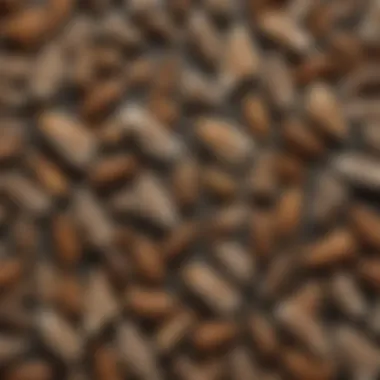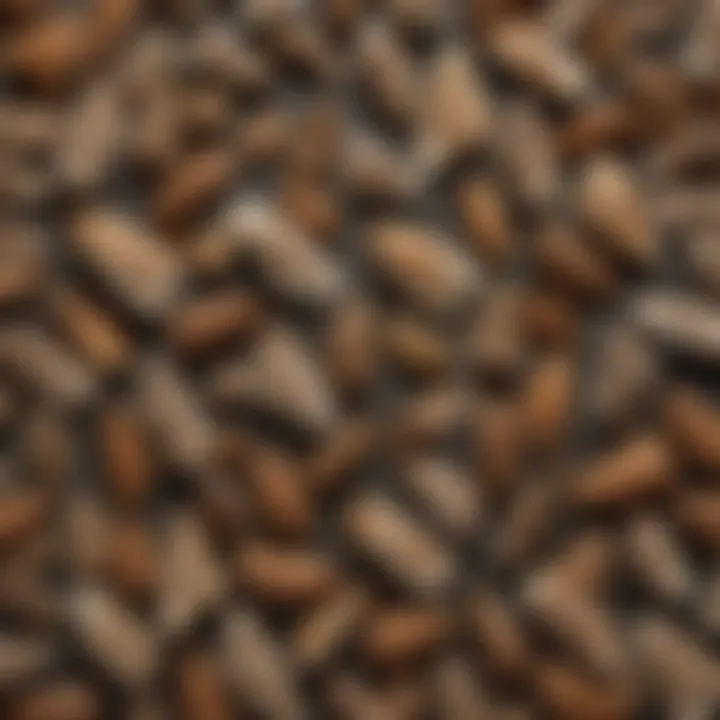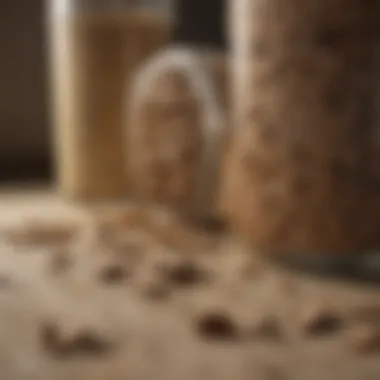Understanding and Managing Small Moths in the Pantry


Intro
The problem of small moths lurking in your pantry is more common than one might think. These pests not only cause damage to food items but also raise concerns about hygiene and health. Being informed about these insects is critical for effective management and prevention. By understanding their behaviors, you can take appropriate actions to maintain a clean and healthy pantry environment.
Understanding Pests
Definition of Pests
Pests are organisms that can cause harm to human health or the environment. In the context of pantries, small moths, commonly known as pantry moths or Indian meal moths, fall under this category. They infest food items such as grains, flour, and even dried fruit. Understanding what constitutes a pest is essential for homeowners to properly identify and address infestations.
Importance of Pest Identification
Correctly identifying these small moths is crucial for effective pest management. There are various species of moths, but pantry moths are identifiable by their distinctive markings and behavior.
Knowing your pest makes prevention and treatment much easier and more effective.
Recognizing the signs of an infestation, such as webbing and moth larvae, helps in timely intervention, preventing further damage.
Prevention Techniques
Home and Garden Preventative Measures
Maintaining cleanliness is the first step in preventing small moths. Regularly clean your pantry, focusing on cracks and crevices where food particles may remain. Seal all food products in airtight containers to make it harder for moths to access them. Consider using bay leaves or essential oils like peppermint, as they can deter moths naturally.
Checking groceries upon purchase is another critical step. Inspect items for any signs of pests before bringing them into the house. By practicing these measures, homeowners can significantly reduce the risk of infestation.
Seasonal Prevention Tips
Certain times of the year can make household pests more prevalent. Change your cleaning routine seasonally—additional focus on your pantry in late spring, when moths are more active, can be beneficial. Properly storing seasonal food items is equally important; consider freezing grains and nuts for a week to kill any potential larvae before storage.
Eco-Friendly Pest Control Solutions
Overview of Sustainable Practices
For those seeking to control pests without harmful chemicals, eco-friendly solutions are available. Integrated Pest Management (IPM) techniques offer a comprehensive approach that emphasizes prevention and monitoring. Utilizing non-toxic methods reduces environmental impact while still addressing the pest problem effectively.
Natural Remedies and Their Effectiveness
Several natural remedies can help in controlling moth populations. Vinegar traps can be effective; simply fill a bowl with vinegar, cover it with plastic wrap, and poke holes in the top. Moths will be attracted to the vinegar but unable to escape.
Other remedies include using diatomaceous earth, which is a non-toxic powder that can kill larvae upon contact. Always ensure you are using such methods safely and use a combination of strategies for the best results.
Prologue to Pantry Moths
Pantry moths are a common problem for many households. Understanding them is essential for effective management and prevention. These insects not only contaminate food, but can also lead to waste, creating both financial and health concerns. The growing awareness of pest control without harmful chemicals highlights the need for knowledge about pantry moths. It will also help in maintaining a clean and safe kitchen environment.
Defining Pantry Moths
Pantry moths are small insects that are attracted to stored food items. Their presence can indicate poor food storage practices. Pantry moths belong to the family Pyralidae, with larvae feeding on various grains, nuts, and dried fruit. Notable for their ability to proliferate, their identification becomes crucial in mitigating their effects.
Common Species Found in Homes
Several species of moths can inhabit pantries. Each species has distinct characteristics and behaviors. To effectively manage pantry moths, knowing these species is vital.
Indian Meal Moth
Indian Meal Moth is perhaps the most widespread pantry pest. This species is recognized by its unique appearance, featuring reddish-brown front wings. A key characteristic of the Indian Meal Moth is its ability to infest a wide range of foods, including keep flour, cereals, and dried fruit. This wide range makes it a significant concern for homeowners. Its larvae produce webbing, a telltale sign of infestation.
Mediterranean Moth
The Mediterranean Moth is another common pantry resident. This moth is less prevalent compared to the Indian Meal Moth but is still a menace. Its distinguishing feature is the striking pattern on its wings, which help in its identification. The Mediterranean Moth often infests grains and processed food products. The damage caused can be significant, particularly in stored grains, leading to possible economic losses.


Rice Moth
Rice Moth, as the name suggests, is frequent in grain products, especially rice. It thrives in warm conditions and can reproduce rapidly. A notable characteristic of the Rice Moth is its longer lifespan compared to others. This can lead to prolonged infestations in the pantry. Homeowners must be vigilant, as their presence can result in considerable damage to stored food.
Understanding these common species assists in targeted pest control strategies.
Knowing how to identify and differentiate these moths will empower homeowners to respond effectively to infestations. Proper identification is critical to developing a proactive approach in managing pantry moths.
Lifecycle of Pantry Moths
Understanding the lifecycle of pantry moths is essential for effective management and prevention. Each stage of their development presents different challenges and opportunities for control. By being familiar with their lifecycle, homeowners can take proactive steps to disrupt it. This knowledge helps in minimizing damage to food supplies and maintains the overall hygiene of the household. Awareness of the stages aids in identifying the presence of moths at various points, ultimately enabling quicker action.
Egg Stage
Pantry moths begin their lifecycle as eggs. Adult female moths, such as the Indian Meal Moth, lay small, nearly invisible eggs in food sources like grains, cereals, and nuts. These eggs are typically laid in clusters, making them difficult to spot. Each female can lay up to 400 eggs, depending on the species and environmental conditions. The egg stage lasts about five to fourteen days, depending on temperature and humidity. This stage is crucial because it marks the beginning of infestation. Homeowners must be vigilant for signs of eggs in their stored food products to prevent larvae from developing.
Larval Stage
Once the eggs hatch, they enter the larval stage. The larvae, often referred to as caterpillars, are light to dark brown and can be highly damaging. They feed on the food items in the pantry, leaving behind frass or fecal matter. Their growth is rapid, lasting about two to three weeks. During this time, larvae can consume a considerable amount of food, leading to contamination and spoilage. Homeowners should regularly check for signs of damage, such as holes in packages or webbing, indicating active larvae.
Pupal Stage
After the larval stage, pantry moth larvae will pupate. During this phase, they create a silken cocoon where they undergo metamorphosis. The pupal stage can last from a few days to several weeks, depending on environmental conditions. Identifying this stage may be more challenging since larvae may hide in corners of pantry shelves or inside food packaging. The length of this stage can affect the overall infestation timeline, highlighting the importance of swift control measures to eliminate larvae before they become adults.
Adult Stage
The adult pantry moth emerges from the pupal stage ready to mate and continue the lifecycle. Adults are small and can vary in color, often identifiable by their characteristics. Indian Meal Moths have a distinctive appearance with grayish wings and reddish-brown tips. Their ability to fly enhances their capacity to spread. Adult moths can live up to several weeks, during which they seek to reproduce. They are more visible than other stages, so monitoring for adults can help indicate a potential infestation.
Understanding each stage of the pantry moth lifecycle allows for targeted intervention strategies. Knowledge about their development equips homeowners with the tools necessary for effective pest management.
By focusing on each lifecycle stage, effective control and prevention strategies can be developed. This comprehensive understanding empowers individuals to protect their essential food supplies while maintaining a pest-free environment.
Detection and Identification
Understanding the detection and identification of pantry moths is essential for effective pest management. Early detection can help limit damage and avoid widespread infestations. By recognizing the signs and characteristics of these pests, homeowners can act promptly to address the issue, conserving food and maintaining cleanliness.
Visual Identification of Adult Moths
Identifying adult pantry moths visually is a foundational step in pest management. The Indian Meal Moth, for instance, has a distinctive appearance. Its wings feature a coppery-brown hue at the front and gray or white on the back. Being familiar with these traits helps in quickly identifying potential invaders. Both the Mediterranean Moth and the Rice Moth also present unique characteristics. The Mediterranean Moth is smaller, with a wingspan measuring around 1/2 inch. Understanding these visible traits aids in early detection and prevention strategies.
Recognizing Larval Damage
Larvae cause considerable damage to stored food products. They tend to feed on items like grains, dried fruits, and nuts. Recognizing this damage is crucial. A key sign of larval presence is found in contaminated food. Often, infested products may appear discolored or have holes. Seeing any of these signs should trigger an inspection of other pantry contents, as larvae can reproduce quickly if not controlled.
Signs of Infestation
Detecting signs of infestation is vital in knowing how to manage pantry moth issues. Two primary indicators stand out: webbing and fecal matter.
Webbing
Webbing often signifies an active infestation. The unique feature of webbing is its sticky texture, which helps protect the larvae from predators. The presence of webbing may indicate that larvae are nearby, feeding on the pantry items. It's commonly found in corners, on food packages, and around containers. Not only is webbing an obvious sign of moth activity, but it also complicates the cleanup process after infestation. Understanding its presence guides homeowners in determining the extent of the issue and taking necessary actions.
Fecal Matter
Fecal matter is another evident sign of pantry moths. This waste appears as small, dark specks, often mistaken for pepper or dirt. The presence of fecal pellets can help pinpoint locations of infestation. Tracking these droppings can reveal how extensive the problem has become. They are usually found near contaminated food products or within storage containers. Ignoring fecal matter can lead to underestimating the moth problem, resulting in repeated infestations. Recognizing and addressing these signs can foster effective management strategies.
Impact of Pantry Moths
Understanding the impact of pantry moths is crucial for effective management and prevention strategies. These pests can lead to significant damage, not only to food products but also to the health of household members. Addressing the implications of these infestations fosters a broader awareness and equips individuals with the knowledge to safeguard their homes.
Damage to Food Products


Pantry moths primarily infest dry food items. They lay eggs in grains, nuts, and dried fruit, among other goods. Once hatched, the larvae feed on these products, leading to visible damage. Common signs include:
- Holes in packaging
- Presence of webbing around infested items
- Discoloration or mold in food products
The cost of replacing damaged food can quickly add up, impacting household budgets. Furthermore, the presence of pantry moths can compromise food quality and safety. Food that has been infested may not only be unpalatable but also potentially unsafe for consumption. Thus, timely detection and management are essential to mitigate these risks.
Health Risks Associated with Infestation
While pantry moths may not pose direct health threats similar to other household pests, their presence can lead to indirect health issues. Infested food can cause allergic reactions or gastrointestinal distress. It is important to consider that the droppings and shed skins of these insects can also contaminate food and surfaces, potentially leading to respiratory problems for sensitive individuals.
Moreover, the psychological impact of an infestation, including stress from dealing with pests and the event of finding pests in food, cannot be underestimated. Maintaining a clean and pest-free environment is essential for both physical and mental well-being.
"Understanding the various impacts of pantry moths allows homeowners to take proactive measures, minimizing risks and promoting a healthier living space."
By taking these factors into account, individuals can better appreciate the significance of managing pantry moth infestations. This comprehensive perspective enhances the strategies homeownes can employ, fostering a healthier living environment.
Preventative Measures
Preventative measures represent a fundamental approach to managing small moths in the pantry. Effective intervention begins long before an infestation occurs. Implementing these strategies can save homeowners from costly pest control services and the stress of dealing with food contamination. A proactive mindset aids in creating an environment that is less attractive to these pests.
Proper Food Storage Techniques
Sealing Containers
Sealing containers play a crucial role in proper food storage. Containers with airtight seals help keep pantry foods protected from potential moth invasions. The primary characteristic of these containers is their ability to prevent air and moisture from entering. This function limits not only the access for moths but also helps to maintain the freshness of food products.
Moreover, using glass or hard plastic containers adds an extra layer of visibility, making it easier to identify any signs of infestation. These containers often come in various sizes, catering to different storage needs. However, it's important to choose high-quality options, as flimsy containers may not provide the needed protection. Overall, well-sealed containers are a beneficial choice for keeping food safe from pantry moths.
Regular Inspection
Regular inspection is another essential practice in the maintenance of a moth-free pantry. Checking stored food items consistently allows homeowners to catch any signs of an infestation early. This practice involves looking for visible signs such as webbing, larvae, or adult moths. The act of routinely checking food packages and containers can reveal potential problems before they escalate.
One key characteristic of regular inspection is the vigilance it encourages. By establishing a schedule for inspections, individuals become more aware of what they have stored and where potential risks may arise. The unique feature of this method is its simplicity and effectiveness. This approach does not require advanced tools or significant investment, making it accessible to everyone. Overall, regular inspections are a highly effective method for early detection and prevention of pantry moth infestations.
Maintaining Cleanliness in the Pantry
Keeping a clean pantry is crucial in the fight against pantry moths. Food crumbs, spills, and residues attract these pests and create a suitable environment for their development. A consistent cleaning routine helps to eliminate these food sources, significantly lowering the chances of an infestation.
Cleaning not only involves wiping down surfaces but also extends to organizing food items. Ensuring food is stored properly and clutter is minimized aids in easier inspections as well. It's advisable to periodically remove all items from the pantry shelves to clean thoroughly and inspect each product for potential signs of pests.
In summary, preventative measures involve adopting clear food storage techniques and establishing a cleanliness routine. These steps not only assure a decline in moth-related issues but also promote a healthier and no-stress kitchen environment. Ultimately, proactive measures such as sealing containers, regular inspections, and maintaining pantry cleanliness can yield long-lasting benefits.
Control Methods
Control methods are critical for addressing pantry moth infestations effectively. These methods encompass a range of strategies aimed at managing existing populations and preventing future infestations. Understanding control methods helps homeowners develop a systematic approach to their pest management efforts. Balancing effectiveness with safety, especially when considering food products, is essential in choosing the right method.
Physical Removal Techniques
Vacuuming
Vacuuming is a prominent physical control technique that significantly contributes to managing pantry moths. This method involves using a vacuum cleaner to eliminate adult moths, larvae, and any detritus that may accompany them. A key characteristic of vacuuming is its immediate effectiveness; it removes the insects directly from the environment.
The unique feature of vacuuming lies in its simplicity and accessibility. Most homes have vacuums, and they can be quickly deployed without the need for special chemicals or complex procedures. However, while vacuuming can reduce the number of visible pests, it does not address any eggs or larvae that might remain in stored food items if not checked thoroughly.
Cleaning
Cleaning is another fundamental technique that plays a vital role in controlling pantry moths. This process involves thoroughly wiping down pantry surfaces, shelves, and any containers where food products are stored. The key characteristic of cleaning is its dual benefit: it helps remove food particles that may attract the pests and eradicates any potential hiding spots for them.
The unique aspect of cleaning is its preventative quality. Regular cleaning can significantly reduce the likelihood of a reinfestation. However, cleaning alone may not suffice if there is already a substantial infestation present. It is often necessary to combine cleaning with other control methods for the best outcome.
Chemical Control Options


Pesticides
Using pesticides can be an effective strategy in controlling pantry moth populations. Pesticides specifically designed for pantry pests contain active ingredients that target and eliminate moths at various life stages. Their key characteristic is that they can penetrate and control large infestations more effectively than most home remedies.
What sets pesticides apart is their speed of action. When applied correctly, they can quickly diminish moth populations, providing swift relief for affected households. However, caution is advised as pesticides can pose risks, especially if not used according to the label directions. Ensuring that any treated areas are kept clean and safe for food storage is essential.
Insect Growth Regulators
Insect Growth Regulators (IGRs) offer a unique approach to managing pantry moths. They do not kill the insects directly but disrupt their development cycle, preventing larvae from maturing into adults. A key characteristic of IGRs is that they target juvenile forms, effectively reducing the population over time.
The unique aspect of IGRs is their long-lasting effects. Once applied, they can prevent re-infestation by inhibiting the growth of new moths. While they are generally considered safe when used as directed, IGRs may take longer to show visible results compared to direct pesticides, requiring patience and consistent application.
Eco-Friendly Alternatives
Diatomaceous Earth
Diatomaceous Earth is a natural, eco-friendly alternative that can be quite effective against pantry moths. It consists of tiny, fossilized algae with sharp edges that damage the exoskeletons of insects upon contact. The key characteristic of Diatomaceous Earth is its ability to provide a physical mode of action rather than chemical, which appeals to those seeking safer pest control options.
The unique feature of this substance is its versatility. It can be applied in various areas where moths may hide, making it suitable for backyard gardens and pantry shelves. However, it requires careful application and can be less effective in humid conditions, as moisture diminishes its efficacy.
Essential Oils
Essential Oils present another eco-friendly option for pantry moth management. Specific oils, such as peppermint and lavender, possess properties that are known to repel pests. A key characteristic of Essential Oils is their pleasant scents, making them appealing for home use.
What differentiates Essential Oils is their dual functionality. Not only can they deter pantry moths, but they can also freshen the air in storage spaces. However, their effectiveness may vary, and regular application is necessary to maintain their repellent properties. They should be used as part of a broader strategy that includes monitoring and other control practices.
Using a combination of control methods increases the chances of successful pantry moth management. Regularly assessing your pantry and employing these techniques diligently will help in sustaining a moth-free environment.
Long-term Management Strategies
Long-term management of pantry moths is essential for maintaining a pest-free environment in your home. An effective strategy goes beyond immediate control methods and focuses on prevention and monitoring. This ensures that once the pantry moths are removed, they do not return. The benefits of long-term strategies include reduced risk of infestation, preservation of food quality, and ultimately, a healthier living space.
Monitoring and Follow-Up
Establishing a routine monitoring system is critical in the long-term management of pantry moths. Regular checks can help catch any signs of new infestations early.
- Visual inspections: Make it a habit to inspect not just pantry items but also the storage space itself. Look for signs like small webbing or larvae.
- Utilization of traps: Pheromone traps can be effective in gauging moth activity. Setting them up can provide an early warning before a full-scale infestation occurs.
Following up on previous control methods is equally important. Post-treatment assessments ensure your strategies are working. Adjustments can be made based on findings during these inspections.
Educating Household Members
Educating all household members about pantry moths plays a significant role in long-term management. When everyone is aware, it raises vigilance against signs of infestation.
- Information sharing: Hold a meeting or send out resources about what to look for. Information could include images of moths, larvae, and damage.
- Standard practices: Encourage practices like sealing food containers tightly and keeping pantry areas clean. These small changes can significantly decrease the chances of future problems.
- Responsibility: Make it clear that everyone shares the responsibility of monitoring and maintaining cleanliness in shared spaces. Engaging family members fosters a cooperative approach to pest management.
By integrating monitoring systems and fostering education among household members, homeowners can significantly reduce the likelihood of pantry moth issues over the long term.
Ending
In any discussion addressing the management of pantry moths, it is crucial to emphasize the importance of comprehensive strategies for prevention and control. This conclusion serves as a synthesis of key elements highlighted throughout the article. The central aim is to equip readers with effective techniques to identify, minimize, and ultimately eliminate infestations of small moths in their food storage areas.
Summarizing Key Points
Throughout this article, numerous aspects concerning pantry moths have been meticulously examined. First, distinct types of pantry moths, such as the Indian Meal Moth, Mediterranean Moth, and Rice Moth, were discussed along with their physical characteristics. Understanding their lifecycles—covering each stage from the egg to the adult moth—provides essential insight into how these pests develop and proliferate.
Detection methods were another crucial focus. Visual identification of adult moths and larval damage are significant indicators of an ongoing infestation. Likewise, key signs of infestation such as webbing and fecal matter were detailed to help readers recognize the problem early, enabling swifter action.
The impact of these pests extends beyond unsightly clutter; it includes actual harm to food products and potential health risks. Hence, preventative measures including proper food storage techniques, maintaining cleanliness, and regular inspections were discussed as critical elements to protect a home.
In addition to these measures, various control methods were highlighted, from physical removal to eco-friendly alternatives such as Diatomaceous Earth and essential oils. It is vital to understand that a combination of strategies may be needed for effective long-term management.
Encouraging Sustainable Practices
Sustainable practices are not only beneficial for one’s pantry but also for the environment. Households can focus on utilizing eco-friendly approaches to prevent pantry moth infestations. For instance, storing food in airtight containers significantly reduces the chances of pest access while also keeping food fresh.
Using natural solutions such as essential oils or organic pest repellents can help in managing pests without resorting to harmful chemicals. Regularly monitoring pantry shelves and educating household members about proper food management practices foster a community effort to keep the space moth-free.
By fostering awareness and implementing these practices, households can significantly reduce the likelihood of pantry moth infestations and promote a healthier home environment. This proactive approach not only addresses current issues but also sets a solid foundation for sustainable living.



